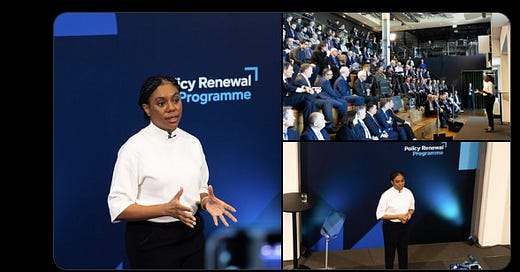Welcome to the 153rd edition of The Week in Polls (TWIP) which takes a quick look at an under-explored topic: how the polling for the Leader of the Opposition and for her party compares.
Then it is a summary of the latest national voting intention polls and a round-up of party leader ratings, followed by, for paid-for subscribers, 10 insights from the last week’s polling and analysis.
This time, those ten include more Runcorn and Helsby by-election polling.
If you are not yet a paid-for subscriber, you can sign up for a free trial now to read that and all the other stories:
Before we get to all that, a quick mention for Pew Research and their very strange polling problem: “How a glitch in an online survey replaced the word ‘yes’ with ‘forks’.”
And with that, on with the show.
Want to know more about political polling? Get my book Polling UnPacked: the history, uses and abuses of political opinion polling.
Is Kemi Badenoch pulling down the Conservatives?
It is widely accepted that both Kemi Badenoch and the Conservative Party are polling badly at the moment. That is, after all, what the polls widely say.
It is also widely assumed in commentary that Badenoch’s poor polling is a problem for the Conservative Party. That her poor performance is dragging her party down (with the implication for some that a change of leader is, or may become, the solution).
But perhaps it isn’t her that is the problem? For there is one simple polling fact that has gone mostly1 without comment. It is that Kemi Badenoch consistently pulls in better net approval ratings than her party.
Take the latest YouGov favourability ratings, for example:
Kemi Badenoch: 18% favourable, 50% unfavourable, net -32%
Conservative Party: 25% favourable, 66% unfavourable, net -41%
Badenoch has lower favourables - 18% versus 25% - but that is because fewer people have views about her rather than her party overall. That is normal for a new(-ish) leader, not yet nearly as familiar to the public as their centuries old party.
It is a similar story with Ipsos:
Kemi Badenoch: 16% favourable, 45% unfavourable, net -29%
Conservative Party: 19% favourable, 53% unfavourable, net -34%
And with More in Common, on a similar metric:
Kemi Badenoch: 16% good job, 35% bad job, net -19%
Conservative Party: 16% good job, 47% bad job, net -31%
This also fits with what focus groups say:
Now, it is true that with both those polls, if one assumes that her ratings change in equal proportion as the don’t knows fall, she would end up with a favourable:unfavourable ratio similar to the Conservative Party.
Even so, it is hard to argue that her ratings are pulling the Conservative Party down, or that her party’s problems are particularly down to her. Of course, there is a degree to which the rating for each (party, leader) interact with the other. But when the leader is doing as well or better than the party, it is hard to sustain an argument that they are the dominant problem.
In as much as the polls can predict the political future, they suggest that simply changing leader would not be not sufficient. With or without a change in leader, the party needs to change too.
Voting intentions and leadership ratings
Here are the latest national general election voting intention polls, sorted by fieldwork dates:
Next, a summary of the latest leadership ratings, sorted by name of pollster. Ed Davey continues generally to have the best net scores, and Keir Starmer seems to be having a bit of a Ukraine-related bump:
For more details, and updates during the week as each new poll comes out, see my regularly updated tables here and follow The Week in Polls on Bluesky.
For the historic figures, including Parliamentary by-election polls, see PollBase.
Catch-up: the previous two editions
My privacy policy and related legal information is available here. Links to purchase books online are usually affiliate links which pay a commission for each sale. For content from YouGov the copyright information is: “YouGov Plc, 2018, © All rights reserved”.2
Quotes from people’s social media messages sometimes include small edits for punctuation and other clarity.
Please note that if you are subscribed to other email lists of mine, unsubscribing from this list will not automatically remove you from the other lists. If you wish to be removed from all lists, simply hit reply and let me know.
How Labour and Conservatives match up against history, and other polling news
The following 10 findings from the most recent polls and analysis are for paying subscribers only, but you can sign up for a free trial to read them straight away.
Dylan Difford has some more of his excellent graphs, giving historical context
Keep reading with a 7-day free trial
Subscribe to The Week in Polls to keep reading this post and get 7 days of free access to the full post archives.







